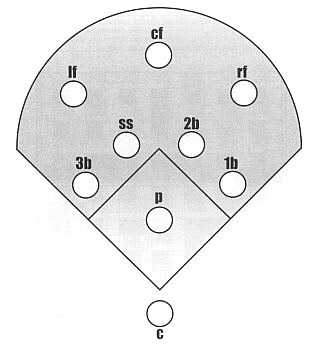Manager Grubb watched from the dugout as his baseball
team took the field. It was the ninth inning and his boys,
the Albuquerque Isotopes, were locked in a 9-9 tie with the Lansing Lugnuts.
Grubb studied the nine players he had positioned on the field:
Simmons, Roe, Blow, Schmoe, Schmidt, Whitt, Kitt, Kent, and Kowalski.
His attention soon became absorbed by the curious fact that his nine players wore on their uniforms the numerals 1, 2, 3, 4, 5, 6, 7, 8, and 9. The more he looked at his players and their numbers, the more he noticed. Grubb's observations are given below as clues, from which you should be able to deduce who played which position, wearing which number.

- The outfielders' names rhymed.
- The outfielders' numbers, from left field around to right, increased and were consecutive.
- The names of the catcher, third baseman, and left fielder all began with the same letter.
- The numbers of the catcher, first baseman, and right fielder had no curves in them.
- The man with the longest name had the highest number.
- The sum of the outfielders' numbers equaled the sum of the infielders' numbers (pitcher and catcher not being considered infielders).
- The number of letters in the pitcher's and catcher's names, added together, was equal to the sum of their uniform numbers.
- The four infielders, reading from first base around to third, were positioned alphabetically.
- The second baseman's number was half the number of letters in the center fielder's name.